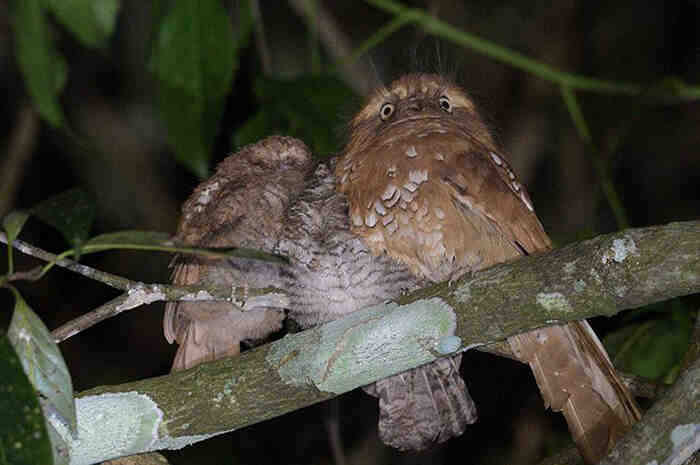Batrachostomus hodgsoni
IUCN
LCBasic Information
Scientific classification
- name:Batrachostomus hodgsoni
- Scientific Name:Batrachostomus hodgsoni,Hodgson's Frogmouth,Black-crowned Frogmouth, Black-crowned Frogmouth
- Outline:Climbing birds
- Family:F.Nighthawks
Vital signs
- length:About 24 cm
- Weight:No verification information
- lifetime:No verification information
Feature
The mouth is wide like a frog
Distribution and Habitat
Mainly distributed in Yunnan, China, Sri Lanka, Assam, India, Myanmar, etc.
Likes to live in evergreen broad-leaved forests, secondary forests, etc.
Appearance
Total length: 240 mm. Eyebrows are brownish white; the front of the eyes and the top of the head are dark brown with reddish brown and grayish white wavy spots; the nape is stained brown, and there is an incomplete white collar ring with black spots behind; the feathers on the head, throat and ear feathers are particularly long, like whiskers; the head, neck and throat are light brownish red, with dense black spots; the rest of the upper body is brownish red with black-brown insect-like spots and spots; the flight feathers are dark brown with brown spots at the tip; the tail feathers are the same color as the back. The chin is brownish white, the chest is the same as the back, with large white spots; the rest of the lower body is white with reddish brown. It lives on trees in the gully rocks. It moves alone. It feeds on insects. It is distributed in western Yunnan.
Details
The Black-capped Frogmouth Nightjar, also known as Hodgson’s Frogmouth in foreign languages, is an internationally endangered species. Its full name is the Black-capped Frogmouth Nightjar. According to the China Forestry Science Data Center, the scientific name of the Black-capped Frogmouth Nightjar is Hodgson’s Frogmouth. After China captured a specimen during an investigation in western Yunnan in 1962, it has never been found again. It is estimated that the population distributed in China is very rare. This bird has a dull body color and is a nocturnal bird. It likes to eat insects, has big eyes, a wide and flat beak, and a very large mouth like a frog’s mouth. There are many long whiskers around the mouth, and it is ferocious. Because it is extremely rare, it is not recorded in the "Shandong Bird List".

The black-capped frogmouthed nightjar is a dusk hunter and night elf, but a complete "lazy bug" during the day. This "reversed jet lag" lifestyle is because the nightjars are "night owls", most of them start foraging at dusk, and some people have seen them successfully catching insects in the air. Compared with being active at dusk and night, the black-capped frogmouth often hides in the dense branches of trees or bushes to sleep during the day, just like the photo in the poster. However, don't think that the black-capped frogmouth is "sleeping to death". In fact, it is always vigilant and will "run away" as soon as there is any disturbance.
In some places in Yunnan, the black-capped frogmouth is called "Old Scared". Especially when children are noisy and don't sleep at night, adults often scare them by saying: "If you don't behave, be careful that 'Old Scared' will come to you at night." Generally, children will be scared and go to sleep obediently. The nickname "Old Fear" full of Yunnan flavor comes from the beak of the black-capped frogmouth. Unlike other birds with long and pointed beaks (a general term for bird beaks), the beak of the black-capped frogmouth is shorter but has an exaggerated width. When it opens its beak, it looks like a toad or a frog. Coupled with its nocturnal habits, it has become the prototype of the folk horror element "Old Fear". Although the nickname is not nice, the black-capped frogmouth is definitely a friend of humans. It can eliminate most types of pests such as moths and locusts. However, due to frequent human activities and the destruction of its habitat, it is now difficult to see the black-capped frogmouth in the wild.
Listed in the second level of the "List of National Key Protected Wildlife in China".
Protect wild animals and stop eating game.
Maintaining ecological balance is everyone's responsibility!








